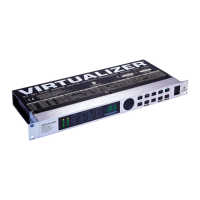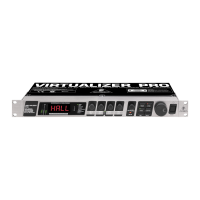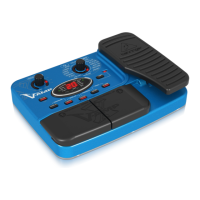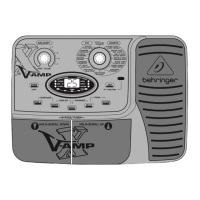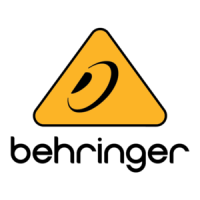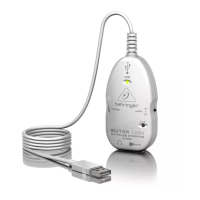SPECIAL
FX
Special eects
VINYLIZER: This eect adds clicks and/or noise to your audio signal,
simulatingold vinyl records and tape recorders.
SAMPLER: This sampler allows you to record up to ve seconds of program
material. Use Edit A for recording and Edit B for playback of the sampled material.
◊ To clear the contents of the sampler, select a different effect.
VOCODER: The vocoder, an old acquaintance, has become popular again due to
the disco renaissance (hear it in “Around the World” by Daft Punk or “California”
by 2Pac). A control signal (usually a voice) is used in the right channel to modulate
another signal which lies on the left channel (usually a synthesizer sound).
Itsounds as if the synthesizer is talking (robot voice).
VOICE CANCELER: The voice canceler is a very eective Karaoke eect. It allows
removal of mono vocal parts in stereo recordings. The bass part, however,
remains untouched.
RESONATOR: A resonator simulates an oscillating system that amplies a specic
frequency. The resonator implemented here has a resonance frequency that can
be modulated with positive and negative feedbacks of up to 100%.
Parameter Function
Speed
Rotations per minute (Vinylizer) / playback speed (Sampler) /
speed of LFO (resonator)
Clicks Level Volume of clicks
Scratch Level Volume of "cracks in the record"
Noise Level Volume of noise
Noise Frequency Frequency response of noise
Record / Stop Start / stop recording
Play / Stop Start / stop playback
Mode
Forward, backward playback, number of repetitions (Sampler) /
Resonator: LFO modulates (LFO), modulation through envelope
follower (ENV), modulation through random generator (RAND)
Sensitivity Modulation intensity / input sensitivity
Attack Response time of envelope follower
Release Release time of envelope follower
Bass Frequency Upper cut-o frequency of bass frequencies that are not eected
MS Balance Degree of mid elimination
Treble Pan Panorama of high frequencies
Gain Gain correction
Depth Modulation depth
Carrier Frequency Modulation frequency
Feedback Degree of feedback
Slewing (Resonator): Smoothing of modulation signal for RAND and SINE
Tone Frequency spectrum of input signal (Vinylizer)
Tab. 2.8: Parameter functions of special eects
2.9
SERIAL
Eects algorithm combinations
(multi-eects programs)
Eects 61 to 71 are multi-eects algorithms, which allow dierent eects to be
used simultaneously. Eect 61, for example, can make a solo guitar “wider” with
chorus and simultaneously add a room reverb. Please note that you can modify
the structure of a multi-eect (see chapters 3.1 and 3.6.4).
CHORUS & REVERB: This algorithm combines the popular chorus with a gold
plate eect (as in algorithm 2).
FLANGER & REVERB: The combination of anger and reverb eects.
LESLIE & REVERB: The input signal, modulated to a degree that you specify,
is then processed with a reverb eect. This eect works especially well with
keyboards and guitars.
PITCH & REVERB: The pitch shifter can be detuned in semitone or cent steps.
The reverb, on the other hand, can be controlled in time and mixing ratio.
DELAY & REVERB: Delay and reverb are the most common combinations for
vocals, solo guitars, etc. The reverb used here is a gold plate, a room that features
a distinctive brilliance and can be used in many ways.
TREMOLO & REVERB: The intensive variation in volume of the tremolo gains
more depth and wideness with the reverb.
PHASER & REVERB: The combination of a classic stereo phaser and a
reverbeect.
CHORUS & DELAY: While the chorus can contribute to a wideness of the signal,
interesting repetition eects can be adjusted with the delay. Vocals can be given
a distinctive eect without making the voice sounding blurred.
FLANGER & DELAY: This eect is just right for creating a modern,
slightly “spacey” vocal sound.
PITCH & DELAY: A repetition of the audio signal, with an oscillatory eect added
by the pitch shifter.
TREMOLO & DELAY: A fast or slow, intensive variation of volume, which is
additionally processed with a panorama eect.
Parameter Function
Speed Modulation speed
Reverb Mix
Wet/dry mix of modulation, delay and reverb eects
(for algorithms 61 - 67)
Decay Room size / duration of reverb tail
Depth Intensity of delay, amplitude, or phase modulation
Doppler Intensity of Doppler eect
Type
(Delay & Reverb): Selects among mono, stereo and ping pong delay or
a lter in the feedback chain
Delay (Time) Length of the delay
Delay Mix (Chorus & Delay): Ratio of chorus and delay
Feedback Degree of feedback
Semitones Detuning in semitones
Cents Detuning in cents
Auto Mod. Inuence on LFO frequency (dependent on the input level)
Hi Damp Damps the high frequencies of the reverb programs
High Cut Frequency range of the input signal (Pitch Shifter & Reverb)
Tab. 2.9: Parameter functions of multi-eects programs
◊ For an overview of the parameters available in the individual programs
refer to chapter 7.1.
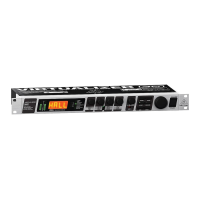
